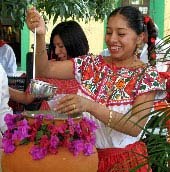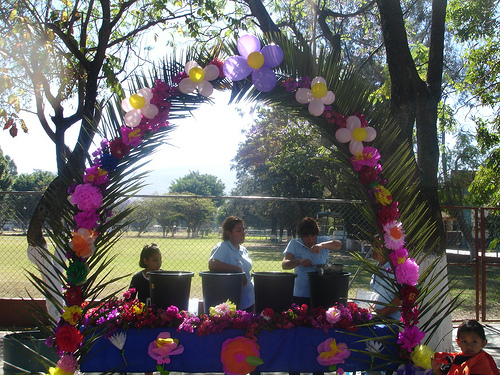My mother had a strict rule at the ranch: We were allowed to have Coca-Cola only once a week, a small bottle every Sunday. The rest of the week she would make delicious refreshing agues frescas (fruit ades) of whatever fruit was available. Dried tamarind and hibiscus flowers were available year-round, and those were popular during early summer. But my favorite was an horchata made with cantaloupe seeds instead of rice, which is the more familiar and difficult-to-make version.

As you drive up to any small town in Mexico, there will be stands serving jewel-colored aguas frescas of watermelon, cantaloupe, orange, lime, papaya, vegetables such as cucumber and chayote, and plants like alfalfa (another favorite). The ingredients depend on the region and Oaxaca has the most varieties. The most surprising is agua de chilacayota, made with a vegetable that is similar to spaghetti squash in that the pulp separates into strings when cooked. Sweetened with piloncillo (unrefined brown sugar), it could be served as a dessert.
There is a beautiful Lenten tradition that recalls the meeting of the Good Samaritan with Jesus Christ at the well. As it’s written in the Gospel of Saint John, Jesus quenched his thirst with freshly drawn water. In Oaxaca, people commemorate this by setting up agua fresca stands all over the city and serving passersby for free.
Agua fresca has spread to the United States, where it is found mostly in Latino neighborhoods or in hipster bars, where they have become a favorite mixer for alcoholic drinks or served as a non-alcoholic option.
Soursop or Other Tropical Fruit Drink
Basic recipe from The Food and Life of Oaxaca
This recipe for soursop — so simple I’m almost embarrassed to use the word “recipe” — is meant as a general model for the many aguas frescas based on Oaxaca’s wealth of tropical fruits.
Chayote-Ade (Agua Fresca de Chayote)
Somehow I had never thought of making an agua fresca out of chayotes until I visited Orizaba, where it is almost a citywide obsession to cook with chayotes in every way, shape and form. (The citizens are nicknamed “chayoteros.”) Although the ones grown in the U.S. aren’t nearly as good as those of Orizaba, the delicate flavor is still pleasantly surprising for this summer drink.
Blackberry Atole (Atole de Mora)
This is an excellent basic recipe for a fruit atole. You can vary the proportions of water and masa to make the drink a little thicker or thinner, and the amount of sugar will depend on the acidity of the fruit. But for 6 or so servings you should always count on using about a pint (or a pound) of any preferred fruit. Today many Latin American markets carry an array of frozen tropical fruits or fruit pulps –- from giant Andean blackberries to passion fruit — that are wonderful for experimenting.


